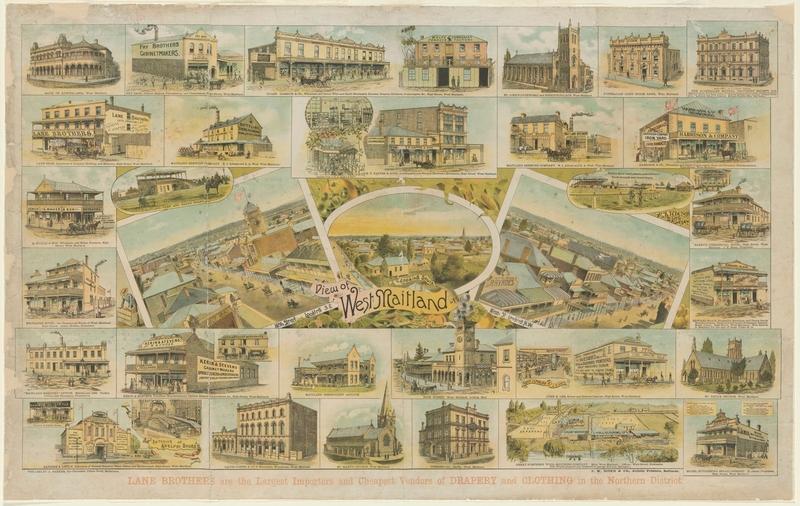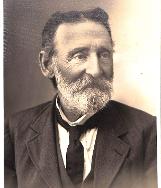Moss, Morris
Maitland : 1862 – 1894
1860s
The first mention of Morris Moss as a photographer appears in the Maitland Mercury in August 1862 when Jacob Audet advises that he has taken Moss into partnership. Moss would continue in the photography business in Maitland until 1894, some 32 years later, with the exception of two years in Newcastle (1873-1874).
In 1864 Moss announces that he has purchased the whole of the business from Audet, with the services of Mr. Audet having been secured until January 1865. [1]
Moss makes an impact with his ‘novelty in photography’ in November 1867:
An operation in photography, which we have not before seen in Maitland, was shown us the other day by Mr. Moss, of the Photographic Company, High-street. This operation is “photographing a ghost," arresting the ethereal, and fixing it on glass or paper. [2]
The Mercury’s relationship with Moss could be characterised as one of ongoing praise and supportfor his work, commencing in February 1868 with his ‘excellent’ photographs, through to superlatives such as: “Wherever art is discussed "Moss" is a household word, and without a doubt that gentleman has a reputation as one of the best photographers in Australia." [3]
Later in 1868, Moss’ portraits of the Prince Alfred Dramatic Club also mentions Aland Watts, local signwriter and painter, with whom Moss collaborates on other occasions. [4]
In addition to photography, Moss’ business also includes the sale of “fancy goods”; his advertisement of 8 May of 1869 indicates that he has just opened six cases, with stationery, jewellery, brooches, charms, toys and portrait albums ‘cheaper than ever’.
1870s
A feature article runs in the Mercury of 21 June 1870 discussing the art of landscape photography, as opposed to portraiture, the predominant form for local photographers, with Moss and Youdale exemplified.
Among some recent out-door photographs, we suppose put forward by the rival artists as specimens of the proposed series of views, was a view of' Sans Souci, by Mr. Youdale; and by Mr. Moss, a representation of the great landslip at the rear of Messrs Owen & Beckett's premises, both very meritorious, each in its different way. [5]
Mr. Moss purposes to make a tour with an omnibus, which is in effect a moveable photographic gallery in most respects, and is provided with the appliances for out-door photography as completely as if it was a stationary building and Mr. Youdale has the same object in view.
No further evidence has been located to suggest these plans were carried out.
In a prominent advertisement in October of 1872 Moss announces he will be leaving Maitland, ‘therefore parties wishing to get a good portrait taken will be obliged to give an early call.’ [6]
Relocating to Newcastle until 1874, Moss’ studio in Maitland becomes the Bank Portrait Rooms in November 1872. [7]
On his return to Maitland in 1874, [8] Moss resumes business as manager of the Great Northern Photographic Company, with a change of address to “nearly opposite Mercury Office” rather than his previous location opposite the Bank of New South Wales, but still in High Street.
1876 sees some major changes for Moss with the remodelling of the gallery and obtaining the services of Mr A. Chandler, of Sydney, “whose name is a sufficient guarantee, that all work for the future will be executed in the latest and best styles of the art.”[9]
When photographs of Maitland are to be produced for show at the International Exhibition, Maitland Mayor notes that Mr. Moss, of West Maitland, had a commission from the Government for this purpose ,[10] however no further information regarding Moss’ role with the international exhibition appeared in the newspapers.
1880s
Advertising on 20 March 1880 Mr. Moss’s assistant is a recent arrival from San Francisco, while in April ‘Moss is going to take the American Gem Photos., New Style.'
A few month's later sees "another novelty in photography" by Moss with the introduction of the Cabinet portrait. [11]
From 1879 to 1885 Moss supported the annual regatta and aquatic sports held in Maitland by the provision of prizes. For the 1881 regatta, Moss would award an enlarged portrait “…to the person who will give the grandest display of his abilities as a swimmer and diver, together with illustrations of how to rescue a drowning person.”[12] Ironically, Moss’ own son escaped drowning just two weeks later, after slipping into the Hunter River near Horseshoe Bend while playing. [13] [access full article]
After producing the delicate novelty of printing photographs onto silk (Mr. Moss being ‘the only photographic artist in the colony who has succeeded’) [14] shortly after, he advertises that he
will be photographing at the Church of England burial ground, Persons wanting Photos of Friends’
Tombstones will please leave their Orders at Gallery, High-street .[15]
The Moss gallery was closed for a week in September 1882 to allow for extensive renovations to be carried out, [16] reopening with admiration from the Maitland Mercury: the pictures now on exhibition certainly outstrip all his previous work. We understand that Mr. Moss has lately obtained from America all the latest improvements required in his art, and by this means he is in a position to do as good work as the American photographers at one-half the cost. [17]
Another new form of photographic output is introduced by Moss in 1883, the ‘exquisite’ opaltype, which according to the Maitland Mercury, has created a stir throughout England and America. [18]
In November 1885 Moss advertises the relocation of his business to the premises known as Hart’s photographic gallery, High Street, opposite Mitchell’s arcade. [19]
Another move occurs the following year, the new premises being opposite the Maitland Mercury office. The first reference to the name “Elite Studio” is made and Moss advertises the range of photographic possibilities: Bijou, Easel, Carte-de-visite, Victorias, Cabinets, Promenades, Boudoirs, and Panel Portraits finished in every style. [20]
The Mercury provides a full description of the new gallery, titled ‘New business premises for Messrs. Rigney and Moss’, appeared on 25 September 1886, including details of the photographic processes undertaken by Moss’ establishment. [access full article]
From April 1887 Moss ran this advertisement in every issue of the Maitland Mercury through November 1888, although after twenty months, the ‘something new’ banner seems somewhat redundant. [21]
After first mentioning landscape photography in 1870, Moss’ efforts come to the fore again in 1889.
With other business interests demanding his attention, Moss transfers the management of his photographic department to the ‘capable hands’ of Mr. George Kedwell [22] who has been with the studio for a number of years.
As far as the Maitland Mercury is concerned, Kedwell proves his competence with ‘a very excellent collection of photographs.’ [23]
1890s
The Moss studio reopens after extensive alterations in December 1891, ‘giving an opportunity for producing photographs superior to those hitherto taken at the well-known gallery.’ [24]
An important achievement for Moss in 1892 is a Maitland panorama published in the picture supplement of the Maitland Mercury of 6 August 1892, showing views of West Maitland, and the principal shops and other chief buildings.

Image: State Library of New South Wales. Viewable online [25]
Another lasting legacy of Moss are a series of photographs depicting the severe flood of March 1893, a description of that flood in the Maitland Mercury indicating the devastation. [access full article]
Some of the Moss flood images are viewable on this website and have been reproduced elsewhere as souvenir documents.[26]
Moss was also a major victim of the flood, with damage to 'pianos, organs and fancy goods, while in the photographic department the loss of negatives is almost incalculable to him.' [27]
Although no definitive date for the end of Moss’ time as a Maitland photographer has been established, by 5 November of 1894 the studio is referred to as Cameron’s Elite Studio. Furthermore the Vandyck Studio advertises their manager as Mr. A Williams, many years Head Operator and Artist at Moss’ perhaps alluding to a change at the Moss studio. [28]
Morris Moss dies at his residence, 120 Glenmore Road, Paddington, Sydney, on 10 September 1905, aged 63 years. [29]
Image: unconfirmed portrait of Moss
